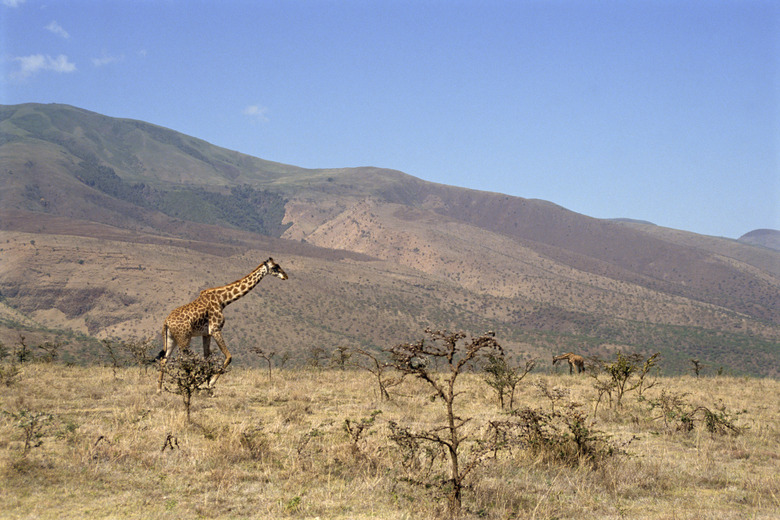Where Is The Location Of The Savanna?
Grassy expanses scattered with trees or shrubs – that's the classic impression of a savanna, an ecological community most often associated with the tropics and subtropics but also found in temperate regions as well. Bridging the gap between open grassland and closed woodland or forest, savannas develop where climate, soil and biological factors – including the influence of humankind – maintain the defining balance between grasses and woody plants.
Savanna Definitions
Savanna Definitions
Ecologists and geographers don't always agree on the exact definition of a savanna or which specific plant communities best illustrate the form. That said, a widely used description of the savanna is a landscape dominated by grasses with some scattered coverage of trees or shrubs. That woody coverage can vary dramatically, from quite sparse in the so-called grass savanna to fairly dense in parkland or savanna woodland, but most authorities would say savanna becomes true woodland where tree canopies overlap.
Tropical and Subtropical Savanna Locations
Tropical and Subtropical Savanna Locations
Extensive swaths of the tropics in Africa, South America, southern Asia and northern Australia support tropical savannas. Much of this extent corresponds to the tropical savanna climate zone, defined by alternating wet and dry seasons. Savanna lands cover large areas of eastern and southern Africa, fringing the continent's equatorial rainforest zone and its northern and southwestern deserts.
Tropical savanna in Africa ranges from fairly well-watered parkland to dry thornbush and scrub. In South America, significant savanna realms include the Llanos in Venezuela and Colombia, the Cerrado of central Brazil and parts of the Gran Chaco in Bolivia, Paraguay and Argentina.
Savannas are scattered but widespread in tropical and subtropical Asia, ranging from acacia and Terminalia savannas of India to dipterocarp savannas of Southeast Asia and pine savannas in southwestern China. Eucalyptus savannas are extensive in the relatively narrow tropical belt of northern Australia.
Temperate Savanna Locations
Temperate Savanna Locations
If savannas are defined as grass-dominated landscapes with some component of trees or shrubs, you can point to many examples outside of the tropics. North America, for instance, has a number of different native plant communities best described as savannas. They include pine savannas, such as the longleaf pine flatwoods of the Atlantic Gulf Coastal Plain and the grassy stands of ponderosa pine in foothills and lower mountainsides of the American West.
Broadleaf savannas are found in the central United States along the transition zone between the eastern deciduous forests and the tallgrass prairies to the west. In the north they include Midwestern oak savannas and, farther south, the oak and oak-hickory savannas of the Cross Timbers of Kansas, Oklahoma and Texas. Oak savannas were also historically widespread in California as well as the Willamette Valley-Puget Trough-Georgia Basin ecoregion of the Pacific Northwest; the American Southwest includes both oak and mesquite savannas.
Natural Factors Controlling Savanna Geographical Locations
Natural Factors Controlling Savanna Geographical Locations
From the acacia and baobab savannas of East Africa and the palm savannas of South America to piney parklands of the American Southeast and West, different savanna ecosystems come about for different reasons. Roughly speaking, they mark zones where grasses and woody plants are in a kind of back-and-forth power struggle – places where there's enough moisture to foster tree and shrub growth, but also where conditions generally favor grass dominance.
Climatic factors are significant for many. The sharp contrast in rainfall between wet and dry seasons in parts of the tropics encourages savanna development, while the savannas of the central United States partly express the gradual decline in precipitation from the moist eastern deciduous realm westward into the semi-arid grasslands of the Great Plains.
Ponderosa savannas in semi-arid western North America often mark lower treelines between downslope grassland or shrubland with low precipitation and closed, mid-elevation conifer forests above with higher precipitation. Soils with low nutrients or that possess hardpan layers limiting water infiltration may also produce savannas by constraining tree growth. Seasonal flooding maintains certain savannas, as in the termite savannas of East Africa, where elevated termite mounds provide a drier refuge for tree growth.
Fire is a major element maintaining many savannas around the world. Places that burn regularly with low-severity surface fires prevent invasion of open savannas by woody understory growth that otherwise could eventually form a closed woodland. These flushing fires may derive from lightning or from intentional human ignition.
For example, traditional indigenous burning helped maintain oak savannas in both the midwestern United States and the Willamette Valley of western Oregon, where annual rainfall is sufficient to otherwise foster closed forest. Grazing by both wild ungulates and domestic stock can also help keep woody encroachment back and maintain open savanna landscapes.
References
- Radford University: Tropical Savannas
- Britannica: Savanna
- Philosophical Transactions of the Royal Society B: Savannahs of Asia: Antiquity, Biogeography, and an Uncertain Future
- World Wildlife Fund: Ecoregions: Upper Midwest Forest-Savanna Transition
- World Wildlife Fund: Ecoregions: Central Forest-Grasslands Transition
Cite This Article
MLA
Shaw, Ethan. "Where Is The Location Of The Savanna?" sciencing.com, https://www.sciencing.com/location-savanna-7386021/. 30 September 2021.
APA
Shaw, Ethan. (2021, September 30). Where Is The Location Of The Savanna?. sciencing.com. Retrieved from https://www.sciencing.com/location-savanna-7386021/
Chicago
Shaw, Ethan. Where Is The Location Of The Savanna? last modified March 24, 2022. https://www.sciencing.com/location-savanna-7386021/
